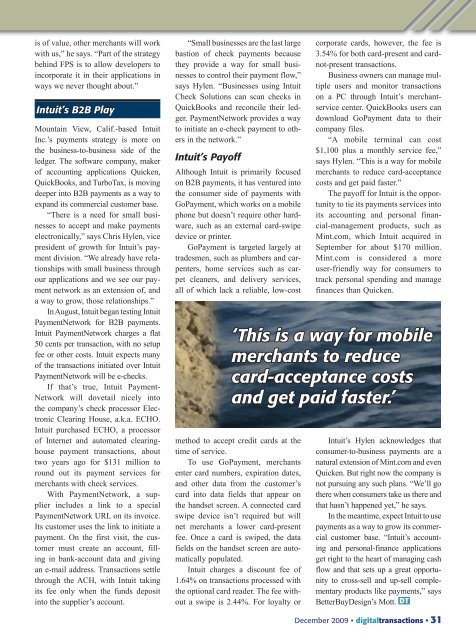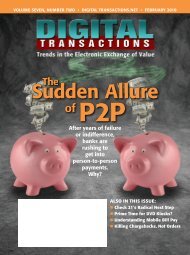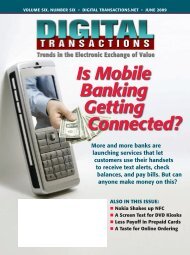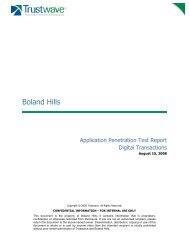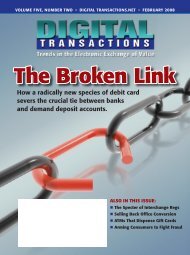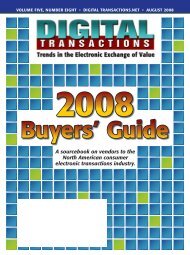Corporate America Discovers Payments - Digital Transactions
Corporate America Discovers Payments - Digital Transactions
Corporate America Discovers Payments - Digital Transactions
You also want an ePaper? Increase the reach of your titles
YUMPU automatically turns print PDFs into web optimized ePapers that Google loves.
is of value, other merchants will workwith us,” he says. “Part of the strategybehind FPS is to allow developers toincorporate it in their applications inways we never thought about.”Intuit’s B2B PlayMountain View, Calif.-based IntuitInc.’s payments strategy is more onthe business-to-business side of theledger. The software company, makerof accounting applications Quicken,QuickBooks, and TurboTax, is movingdeeper into B2B payments as a way toexpand its commercial customer base.“There is a need for small businessesto accept and make paymentselectronically,” says Chris Hylen, vicepresident of growth for Intuit’s paymentdivision. “We already have relationshipswith small business throughour applications and we see our paymentnetwork as an extension of, anda way to grow, those relationships.”In August, Intuit began testing IntuitPaymentNetwork for B2B payments.Intuit PaymentNetwork charges a flat50 cents per transaction, with no setupfee or other costs. Intuit expects manyof the transactions initiated over IntuitPaymentNetwork will be e-checks.If that’s true, Intuit Payment-Network will dovetail nicely intothe company’s check processor ElectronicClearing House, a.k.a. ECHO.Intuit purchased ECHO, a processorof Internet and automated clearinghousepayment transactions, abouttwo years ago for $131 million toround out its payment services formerchants with check services.With PaymentNetwork, a supplierincludes a link to a specialPaymentNetwork URL on its invoice.Its customer uses the link to initiate apayment. On the first visit, the customermust create an account, fillingin bank-account data and givingan e-mail address. <strong>Transactions</strong> settlethrough the ACH, with Intuit takingits fee only when the funds depositinto the supplier’s account.“Small businesses are the last largebastion of check payments becausethey provide a way for small businessesto control their payment flow,”says Hylen. “Businesses using IntuitCheck Solutions can scan checks inQuickBooks and reconcile their ledger.PaymentNetwork provides a wayto initiate an e-check payment to othersin the network.”Intuit’s PayoffAlthough Intuit is primarily focusedon B2B payments, it has ventured intothe consumer side of payments withGoPayment, which works on a mobilephone but doesn’t require other hardware,such as an external card-swipedevice or printer.GoPayment is targeted largely attradesmen, such as plumbers and carpenters,home services such as carpetcleaners, and delivery services,all of which lack a reliable, low-costmethod to accept credit cards at thetime of service.To use GoPayment, merchantsenter card numbers, expiration dates,and other data from the customer’scard into data fields that appear onthe handset screen. A connected cardswipe device isn’t required but willnet merchants a lower card-presentfee. Once a card is swiped, the datafields on the handset screen are automaticallypopulated.Intuit charges a discount fee of1.64% on transactions processed withthe optional card reader. The fee withouta swipe is 2.44%. For loyalty orcorporate cards, however, the fee is3.54% for both card-present and cardnot-presenttransactions.Business owners can manage multipleusers and monitor transactionson a PC through Intuit’s merchantservicecenter. QuickBooks users candownload GoPayment data to theircompany files.“A mobile terminal can cost$1,100 plus a monthly service fee,”says Hylen. “This is a way for mobilemerchants to reduce card-acceptancecosts and get paid faster.”The payoff for Intuit is the opportunityto tie its payments services intoits accounting and personal financial-managementproducts, such asMint.com, which Intuit acquired inSeptember for about $170 million.Mint.com is considered a moreuser-friendly way for consumers totrack personal spending and managefinances than Quicken.‘This is a way for mobilemerchants to reducecard-acceptance costsand get paid faster.’Intuit’s Hylen acknowledges thatconsumer-to-business payments are anatural extension of Mint.com and evenQuicken. But right now the company isnot pursuing any such plans. “We’ll gothere when consumers take us there andthat hasn’t happened yet,” he says.In the meantime, expect Intuit to usepayments as a way to grow its commercialcustomer base. “Intuit’s accountingand personal-finance applicationsget right to the heart of managing cashflow and that sets up a great opportunityto cross-sell and up-sell complementaryproducts like payments,” saysBetterBuyDesign’s Mott. DTdigital31


